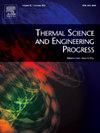富氢压缩天然气发动机的性能、排放及热力学分析
IF 5.1
3区 工程技术
Q2 ENERGY & FUELS
引用次数: 0
摘要
在汽车中使用氢作为燃料将促进能源安全并减少温室气体排放。本研究考察了压缩天然气(CNG)燃料火花点火(SI)发动机在低负荷和低速条件下各种参数对化学计量操作的影响。在化学计量学条件下,分析了低负荷(30%)和低速(900-1100 rpm)下不同的氢气比(0 - 50%)、废气循环(EGR)比(0 - 20.6%)和火花正时(4-44°CA bTDC)对发动机性能的影响。研究了扭矩、制动热效率、NOX、CO2、CO、THC、CH4、缸内压力-体积曲线、质量分数燃烧以及传热率、制动功率、摩擦功率和功率的热力学分析。排气热率来计算实验室基础的CNG SI发动机的适用性。与最大制动扭矩提升2°CA的CNG燃料相比,HCNG20的峰值扭矩提高了1.18%。最大制动热效率提高3.17%,废气再循环增加6%,最大制动扭矩延迟4°CA。加入氢馏分可以降低CO2、CO、THC和CH4的排放,并通过提高EGR降低NOx的排放。热力学分析表明,HCNG30燃料在32°CA bTDC时燃烧时的最大制动功率为总燃料能量的35%,EGR为14.8%;HCNG10燃料在14°CA bTDC时燃烧时的最小排气热率为总燃料能量的16%,EGR为0%。本文章由计算机程序翻译,如有差异,请以英文原文为准。
Performance, emissions and thermodynamic analysis of hydrogen-enriched compressed natural gas engine
Hydrogen utilization as fuel in vehicle fleets would develop energy security and decrease greenhouse gas emissions. This current study examines the effect of various parameters under low load and low-speed conditions on a compressed natural gas (CNG) fueled spark ignition (SI) engine on stoichiometric operation. The experiment was directed to analyze the effect of different hydrogen ratios (0–50 %), exhaust gas circulation (EGR) ratios (0–20.6 %), and Spark timing (4–44 °CA bTDC) with a low load of 30 % and low speed (900–1100 rpm) under stoichiometric conditions. There are several parameters have been investigated as torque, brake thermal efficiency, NOX, CO2, CO, THC, CH4, in-cylinder pressure–volume curves, mass fraction burns and thermodynamic analysis with heat transfer rate, brake power, friction power& exhaust heat rate to calculate the suitability of a laboratory-based CNG SI engine. The peak torque is increased by 1.18 % with the count of HCNG20 in comparison to CNG fuel with 2°CA advancement in maximum brake torque. The maximum brake thermal efficiency increases by 3.17 % to increase 6 % exhaust gas recirculation and also 4°CA retard the maximum brake torque. Adding hydrogen fraction lessens CO2, CO, THC and CH4 emissions and decreases NOx by increasing the EGR. Thermodynamic analysis reveals that, the maximum brake power during the combustion of HCNG30 fuel is 35 % of total fuel energy with 14.8 % EGR at 32 °CA bTDC and the minimum exhaust heat rate during the combustion of HCNG10 fuel is 16 % of total fuel energy with 0 % EGR at 14 °CA bTDC.
求助全文
通过发布文献求助,成功后即可免费获取论文全文。
去求助
来源期刊

Thermal Science and Engineering Progress
Chemical Engineering-Fluid Flow and Transfer Processes
CiteScore
7.20
自引率
10.40%
发文量
327
审稿时长
41 days
期刊介绍:
Thermal Science and Engineering Progress (TSEP) publishes original, high-quality research articles that span activities ranging from fundamental scientific research and discussion of the more controversial thermodynamic theories, to developments in thermal engineering that are in many instances examples of the way scientists and engineers are addressing the challenges facing a growing population – smart cities and global warming – maximising thermodynamic efficiencies and minimising all heat losses. It is intended that these will be of current relevance and interest to industry, academia and other practitioners. It is evident that many specialised journals in thermal and, to some extent, in fluid disciplines tend to focus on topics that can be classified as fundamental in nature, or are ‘applied’ and near-market. Thermal Science and Engineering Progress will bridge the gap between these two areas, allowing authors to make an easy choice, should they or a journal editor feel that their papers are ‘out of scope’ when considering other journals. The range of topics covered by Thermal Science and Engineering Progress addresses the rapid rate of development being made in thermal transfer processes as they affect traditional fields, and important growth in the topical research areas of aerospace, thermal biological and medical systems, electronics and nano-technologies, renewable energy systems, food production (including agriculture), and the need to minimise man-made thermal impacts on climate change. Review articles on appropriate topics for TSEP are encouraged, although until TSEP is fully established, these will be limited in number. Before submitting such articles, please contact one of the Editors, or a member of the Editorial Advisory Board with an outline of your proposal and your expertise in the area of your review.
 求助内容:
求助内容: 应助结果提醒方式:
应助结果提醒方式:


